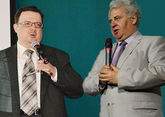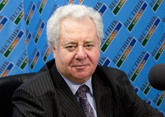Vestnik Kavkaza continues a series of interviews with the president of the Russian State University for the Humanities, member of the Council of the Russian Historical Society Yefim Pivovar. The topic of the last interview was the RHS projects, and this interview is about the preparation of a post-Soviet countries history teaching guide.
- The preparation of a CIS countries history teaching guide is nearing completion. Please tell us about this project. What difficulties did you face?
- Nearing completion is the right phrase. Events in Kazakhstan, which occurred last week, require that this work should continue [This refers to the resignation of the republic's first president Nursultan Nazarbayev, - VK]. The post-Soviet space is a young participant in international politics, although the history of the peoples living in this territory goes back thousands of years. Developments in all the post-Soviet republics are swift, so it will be difficult for us, the teaching guide's authors, to stop our work.
We have been teaching the course in the near abroad history at the history department of the Moscow State University and the course in post-Soviet near abroad history at the RSUH for quite a long time, not only to historians, but also to international affairs students. We have accumulated the material. When we've been working on the concept, we understood that it should have at least two parts: the chapters devoted to individual countries, as well as chapters about the processes taking place within the whole space. So far, we have chosen two key points from the second section.
The first section is devoted to integration processes in the post-Soviet space. These are both integration processes within the space, as well as those involving individual countries or groups of countries. These integration associations are wider than the post-Soviet space. And even those associations, which to some extent were intended as opposition from the post-Soviet space, it should also not be forgotten. The tangle of these organizations, their formation, development, trends are considered in this section. The second section is devoted to the economic interaction between these countries.
In addition, we want to prepare chapters on all post-Soviet countries. They have completely different fates, they represent different civilization models, they have different histories of entering separate empires, separate states. But then why should they be viewed as a communion? Because at certain stages all of them were part of a single state entity - either the Russian Empire or the USSR. That is why they have a common past, which allows us to consider these states as a whole.
- Who is engaged in preparing the teaching guide?
- The authors are, first of all, the staff of the Department of History of the CIS countries of the Faculty of History of the Moscow State University and the staff of the Institute of Post-Soviet Studies of RSUH. We have been working long enough and hard on it. When I started to re-read the teaching guide, I realized that it needs additions. The difficulty is also that there are no analogues against which it could be compared. Perhaps someday it will become a textbook, but in a different composition, in a different capacity. And in the meantime, this is a manual useful for both students and those who deal with these problems during scientific studies.
- Do you have an approximate time frame?
- The countries' history from ancient times to the present day. We want to show the cultural achievements of peoples, geographical factors, as well as such things as diasporas, foreign policy, domestic policy. It is clear that one cannot seize the unseizable. We know examples of multi-volumes in each country, but these are almost encyclopedias. Of course, it's a very difficult issue of what should be included in the manual and what should not be, since there is much more material than we may use in it.
- In your opinion, what is the significance of this manual for historical studies?
- It’s not for me to judge its meaning. We carry out the obligatory task, since the course is already being taught. The manual will be useful for both teachers to prepare lectures and students to prepare for exams. We wanted to create a base to start with. It is clear that it's not the end of the process, it is just beginning. Our field does not have a long classical period of research, it is young, like the object itself. Practically up to the 2000s there were no such studies at all, as well as personnel to address them. And now there are dozens of candidates of science, there are doctors of science which defended a thesis on this topic. Thus, this process is on the rise. Nevertheless, almost any topic - Kazakh studies, Azerbaijan studies, Ukrainian studies, Belarusian studies - is not a completely understood and studied direction.
- If we talk about Russian society, how popular is the CIS topic now?
- Its value increases. First, we increasingly understand that in a multipolar world, value is not determined by the size of a country, not by just economic indicators or achievements in science or culture, but also by the place and geographical position in which a particular country develops. Second, relationships with neighbors are becoming increasingly important. Geography can not be changed. Of course, one can have a spat with neighbors, but nothing good will come of it. Neighbors can not be changed, things like that do not happen in history. It seems to me that society increasingly understands the value of Russia's fruitful mutually beneficial relations with its neighbors: both for the formation of markets, the formation of labor and the formation of cultural exchanges considering the common past, which is manifested in the present and will be manifested in the future. We are destined, in a good sense, to pay increasing attention to neighbors and those with whom we have a common past. Everything is interconnected, all countries, all nations, but relations with neighbors are especially important.










